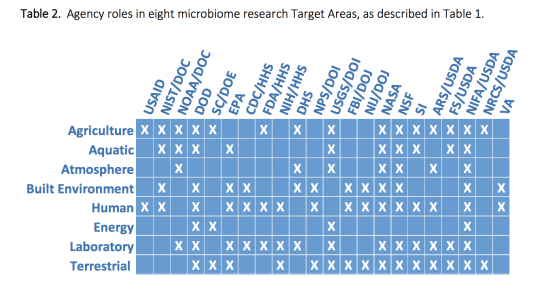A number of Federal agencies have announced a strategic plan to fund and shape the future of microbiome research , and the Built Environment is one of the priority areas! The Plan includes steps to increase funding for research, including personnel and virtual infrastructure costs, as well as education and public engagement.

The full Strategic Plan can be found here;
“Executive Summary
Microbiome science aims to advance understanding of microbial communities (microbiomes) for applications in areas such as health care, food production, and environmental restoration to benefit individuals, communities, and the planet. Microbiomes—the communities of microorganisms (such as bacteria, viruses, or fungi) that live on, in, and around people, plants, animals, soil, oceans, and the atmosphere—contribute to our health and livelihoods. Microbiomes are key to maintaining healthy function of diverse ecosystems. They have positive influences on human health, they are responsible for global climate cycles, and benign communities improve food security and have other impacts such as enabling effective wastewater treatment. Dysfunctional microbiomes are associated with numerous problems, including chronic human diseases such as obesity, diabetes, and asthma; disruption of beneficial ecosystem services caused by ecosystem imbalance, such as the hypoxic zone in the Gulf of Mexico; and reductions in agricultural productivity, such as increases in antimicrobial resistance in livestock and poultry. A multitude of industrial processes, such as biofuel production and many food processing operations, depend on healthy microbial communities. Several global ecosystem services, such as nutrient cycling, soil organic matter formation, soil aggregation, and water purification depend on fully functional soil microbiomes. Our nation’s food and fiber production likewise depend on soil health—a complex combination of microbes and their mediated functions. Contamination or alteration of the active soil microbiome communities can lead to reduced efficiency or lost productivity. New technologies in genetics, genomics, and other fields have enabled exciting discoveries about the importance of microbiomes. The next steps—to further understand and then manage microbiome systems to maintain health, prevent imbalance or dysfunction, and restore function when damaged— require additional knowledge and tools. Given the connection between microbiomes and a broad spectrum of important issues, Federal agencies have converged on three recommended areas of focus to transform microbiome discoveries to solutions:
1. Supporting interdisciplinary and collaborative research to enable a predictive understanding of the function of microbiomes in diverse ecosystems to enhance public health, food, and environmental security and grow new bioeconomy product areas.
2. Developing platform technologies to generate critical insights and to improve access to and sharing of microbiome data across ecosystems.
3. Expanding the microbiome workforce through educational opportunities, citizen science, and public engagement.
This five-year Strategic Plan coordinates microbiome research activities across 21 U.S. government agencies, describing the interagency objectives, structure and operating principles, and research focus areas. This plan demonstrates commonalities that can be leveraged and thus represents an opportunity to increase Federal efficiency.”